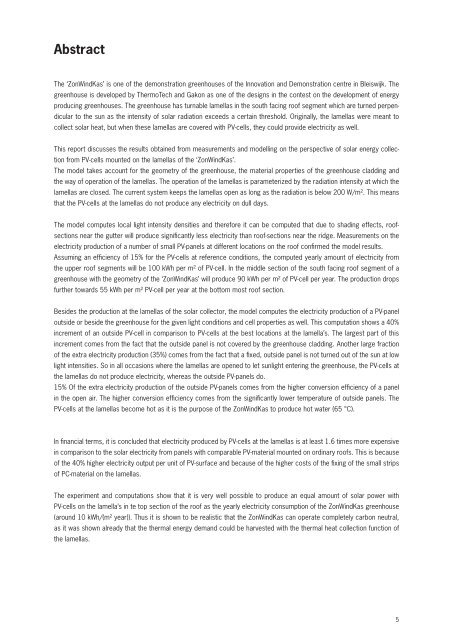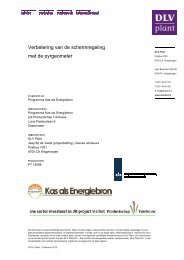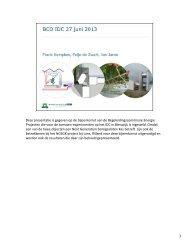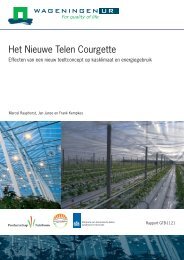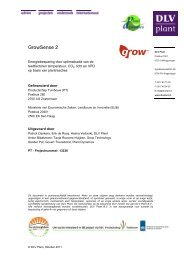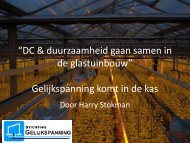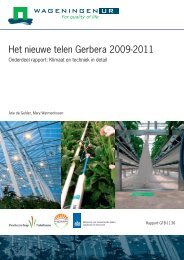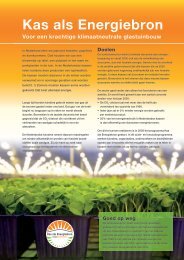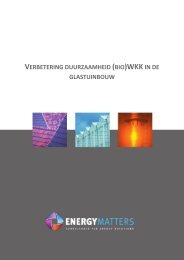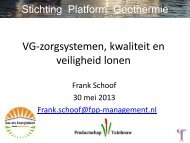PV-cellen op de ZonWindKas - Energiek2020
PV-cellen op de ZonWindKas - Energiek2020
PV-cellen op de ZonWindKas - Energiek2020
You also want an ePaper? Increase the reach of your titles
YUMPU automatically turns print PDFs into web optimized ePapers that Google loves.
AbstractThe ‘<strong>ZonWindKas</strong>’ is one of the <strong>de</strong>monstration greenhouses of the Innovation and Demonstration centre in Bleiswijk. Thegreenhouse is <strong>de</strong>vel<strong>op</strong>ed by ThermoTech and Gakon as one of the <strong>de</strong>signs in the contest on the <strong>de</strong>vel<strong>op</strong>ment of energyproducing greenhouses. The greenhouse has turnable lamellas in the south facing roof segment which are turned perpendicularto the sun as the intensity of solar radiation exceeds a certain threshold. Originally, the lamellas were meant tocollect solar heat, but when these lamellas are covered with <strong>PV</strong>-cells, they could provi<strong>de</strong> electricity as well.This report discusses the results obtained from measurements and mo<strong>de</strong>lling on the perspective of solar energy collectionfrom <strong>PV</strong>-cells mounted on the lamellas of the ‘<strong>ZonWindKas</strong>’.The mo<strong>de</strong>l takes account for the geometry of the greenhouse, the material pr<strong>op</strong>erties of the greenhouse cladding andthe way of <strong>op</strong>eration of the lamellas. The <strong>op</strong>eration of the lamellas is parameterized by the radiation intensity at which thelamellas are closed. The current system keeps the lamellas <strong>op</strong>en as long as the radiation is below 200 W/m². This meansthat the <strong>PV</strong>-cells at the lamellas do not produce any electricity on dull days.The mo<strong>de</strong>l computes local light intensity <strong>de</strong>nsities and therefore it can be computed that due to shading effects, roofsectionsnear the gutter will produce significantly less electricity than roof-sections near the ridge. Measurements on theelectricity production of a number of small <strong>PV</strong>-panels at different locations on the roof confirmed the mo<strong>de</strong>l results.Assuming an efficiency of 15% for the <strong>PV</strong>-cells at reference conditions, the computed yearly amount of electricity fromthe upper roof segments will be 100 kWh per m² of <strong>PV</strong>-cell. In the middle section of the south facing roof segment of agreenhouse with the geometry of the ‘<strong>ZonWindKas</strong>’ will produce 90 kWh per m² of <strong>PV</strong>-cell per year. The production dr<strong>op</strong>sfurther towards 55 kWh per m² <strong>PV</strong>-cell per year at the bottom most roof section.Besi<strong>de</strong>s the production at the lamellas of the solar collector, the mo<strong>de</strong>l computes the electricity production of a <strong>PV</strong>-paneloutsi<strong>de</strong> or besi<strong>de</strong> the greenhouse for the given light conditions and cell pr<strong>op</strong>erties as well. This computation shows a 40%increment of an outsi<strong>de</strong> <strong>PV</strong>-cell in comparison to <strong>PV</strong>-cells at the best locations at the lamella’s. The largest part of thisincrement comes from the fact that the outsi<strong>de</strong> panel is not covered by the greenhouse cladding. Another large fractionof the extra electricity production (35%) comes from the fact that a fixed, outsi<strong>de</strong> panel is not turned out of the sun at lowlight intensities. So in all occasions where the lamellas are <strong>op</strong>ened to let sunlight entering the greenhouse, the <strong>PV</strong>-cells atthe lamellas do not produce electricity, whereas the outsi<strong>de</strong> <strong>PV</strong>-panels do.15% Of the extra electricity production of the outsi<strong>de</strong> <strong>PV</strong>-panels comes from the higher conversion efficiency of a panelin the <strong>op</strong>en air. The higher conversion efficiency comes from the significantly lower temperature of outsi<strong>de</strong> panels. The<strong>PV</strong>-cells at the lamellas become hot as it is the purpose of the <strong>ZonWindKas</strong> to produce hot water (65 °C).In financial terms, it is conclu<strong>de</strong>d that electricity produced by <strong>PV</strong>-cells at the lamellas is at least 1.6 times more expensivein comparison to the solar electricity from panels with comparable <strong>PV</strong>-material mounted on ordinary roofs. This is becauseof the 40% higher electricity output per unit of <strong>PV</strong>-surface and because of the higher costs of the fixing of the small stripsof PC-material on the lamellas.The experiment and computations show that it is very well possible to produce an equal amount of solar power with<strong>PV</strong>-cells on the lamella’s in te t<strong>op</strong> section of the roof as the yearly electricity consumption of the <strong>ZonWindKas</strong> greenhouse(around 10 kWh/(m² year)). Thus it is shown to be realistic that the <strong>ZonWindKas</strong> can <strong>op</strong>erate completely carbon neutral,as it was shown already that the thermal energy <strong>de</strong>mand could be harvested with the thermal heat collection function ofthe lamellas.5


